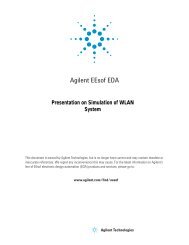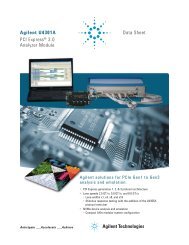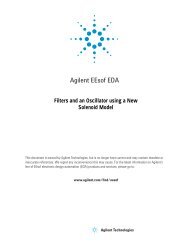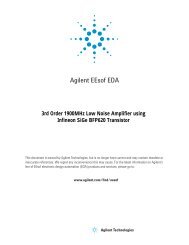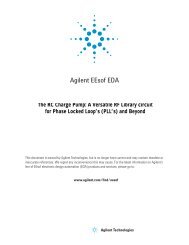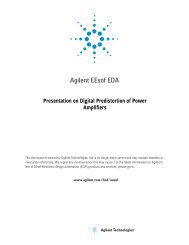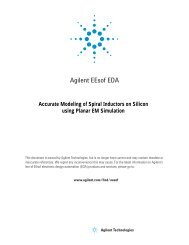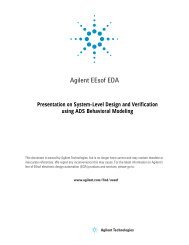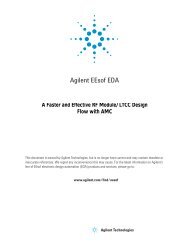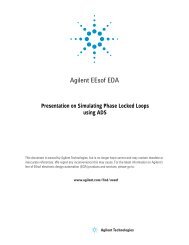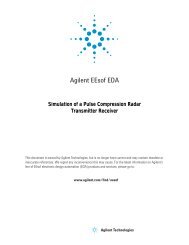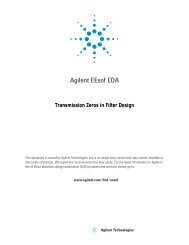Agilent 34980A Multifunction Switch/Measure Unit *34980-90005*
Agilent 34980A Multifunction Switch/Measure Unit *34980-90005*
Agilent 34980A Multifunction Switch/Measure Unit *34980-90005*
You also want an ePaper? Increase the reach of your titles
YUMPU automatically turns print PDFs into web optimized ePapers that Google loves.
3 Features and Functions<br />
Alarm Limits<br />
The instrument has four alarms which you can configure to alert you<br />
when a reading exceeds specified limits on a channel during a scan. <br />
You can assign a high limit, a low limit, or both to any configured channel<br />
in the scan list. You can assign multiple channels to any of the four<br />
available alarms (numbered 1 through 4). For example, you can configure<br />
the instrument to generate an alarm on the Alarm 1 output when a limit<br />
is exceeded on any of channels 1003, 2025, or 3020.<br />
You can also assign alarms to channels on the modules with digital I/O<br />
capabilities (34950A and 34952A). For example, you can generate an alarm<br />
when a specific bit pattern or bit pattern change is detected on a digital<br />
input channel or when a specific count is reached on a totalizer channel.<br />
With the digital modules, the channels do not have to be part of the scan<br />
list to generate an alarm. For complete details, see “Using Alarms With the<br />
Digital Modules” on page 138.<br />
Alarm data can be stored in one of two locations depending on whether a<br />
scan is running when the alarm occurs.<br />
1 If an alarm event occurs on a channel as it is being scanned, then that<br />
channel’s alarm status is stored in reading memory as the readings are<br />
taken. Each reading that is outside the specified alarm limits is logged<br />
in memory. You can store at least 500,000 readings in memory during <br />
a scan. You can read the contents of reading memory at any time, even<br />
during a scan. Reading memory is not cleared when you read it.<br />
2 As alarm events are generated, they are also logged in an alarm queue,<br />
which is separate from reading memory. This is the only place where<br />
non- scanned alarms get logged (alarms during a monitor, alarms<br />
generated by the digital modules, etc.). Up to 20 alarms can be logged<br />
in the alarm queue. If more than 20 alarm events are generated, they<br />
will be lost (only the first 20 alarms are saved). Even if the alarm<br />
queue is full, the alarm status is still stored in reading memory during<br />
a scan. The alarm queue is cleared by the *CLS (clear status) command,<br />
when power is cycled, and by reading all of the entries. A Factory Reset<br />
(*RST command) does not clear the alarm queue.<br />
You can assign an alarm to any configured channel and multiple<br />
channels can be assigned to the same alarm number. However, <br />
you cannot assign alarms on a specific channel to more than one <br />
alarm number.<br />
When an alarm occurs, the instrument stores relevant information about<br />
the alarm in the queue. This includes the reading that caused the<br />
alarm, the time of day and date of the alarm, and the channel number<br />
on which the alarm occurred. The information stored in the alarm<br />
queue is always in absolute time format and is not affected by the<br />
FORMat:READing:TIME:TYPE command setting.<br />
132 <strong>Agilent</strong> <strong>34980A</strong> Mainframe User’s Guide





